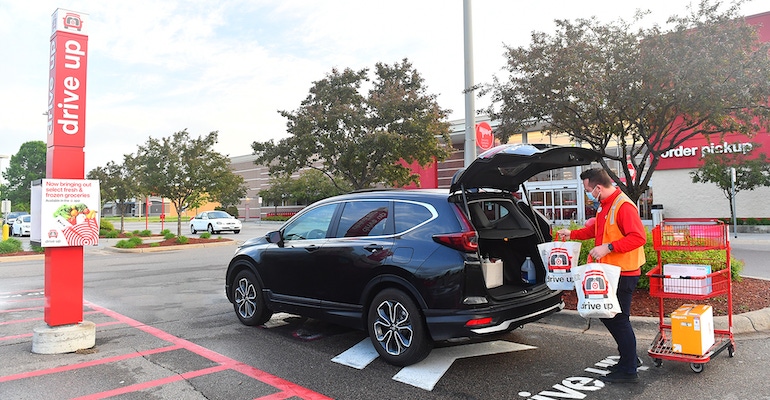U.S. e-grocery sales trend down again in May
Rising inflation has consumers rethinking where and how they shop online for groceries, Brick Meets Click survey shows
June 13, 2022

Online grocery sales fell again on a sequential basis in May, with the month-to-month decrease nearly double the size of the decline in April, strategic advisory firm Brick Meets Click reported.
The U.S. online grocery market totaled $7.1 billion for May, down 12.3% from $8.1 billion in April, when sales had dipped 6.9% month to month, according to the latest Brick Meets Click/Mercatus Grocery Shopping Survey, released Monday. April’s total was down from $8.7 billion in March and February, which signaled an uptick following a 4.5% month-to-month decrease to $8.5 billion in January.
On a year-over-year basis, May e-grocery sales edged up 1.7%, following declines of 3.8% in April and 6.5% in March, an 8.5% increase in February and an 8.6% decrease in January.
Growth in pickup and delivery sales helped fuel the e-grocery market in May. Pickup accounted for 45% ($3.2 billion) of online grocery sales for the month, up 9% versus last year, driven mainly by more than 10% growth in the monthly active user (MAU) base for click-and-collect service, Brick Meets Click said. A mid-single-digit uptick in average order value (AOV) for pickup was offset by a nominal drop in order frequency during the month. Delivery tallied a dollar share of 36% ($2.5 billion) in May, up 5% from a year ago, and saw more modest gains in MAUs and AOV versus pickup and an approximately 5% decrease in order frequency.

Meanwhile, ship-to-home sales represented 19% ($1.4 billion) of online grocery sales in May, down 16% year over year as a 10%-plus decline in AOV and similar decrease in order frequency was only partially offset by a more than 9% gain in the MAU base.
Conducted May 28 and 29 by Brick Meets Click, and sponsored by grocery e-commerce specialist Mercatus, the survey polled 1,802 U.S. adults who participated in their household’s grocery shopping and made an online grocery purchase in the previous 30 days. Delivery includes retailer and third-party services (e.g. Instacart, Shipt), while pickup includes in-store, curbside, locker and drive-up services. Ship-to-home sales cover online grocery purchases delivered by parcel couriers like Federal Express, UPS and the U.S. Postal Service.
Brick Meets Click noted that rising food price inflation is influencing where and how consumers shop online for groceries. As escalating prices sap purchasing power, grocery customers are searching for ways to pay no more than necessary when shopping online, explained the Barrington, Ill.-based advisory firm, which focuses on how digital technology impacts food sales and marketing.
For example, 43% of mass merchant and supermarket shoppers using pickup or delivery in May cited cost as the chief retailer selection criterion, compared with 37% in August 2020, when customers were first asked that question. Notably, Brick Meets Click said, the share of mass customers who named cost as the top consideration remained relatively unchanged over this period, whereas the share of grocery store customers citing cost as the top concern jumped over 10 percentage points.
“Less than one-quarter of online grocery customers who shop with grocery or mass online use both pickup and delivery services, so the increased cost consideration within this group may actually drive more demand toward pickup,” according to David Bishop, partner at Brick Meets Click. “Interestingly, for grocery customers, the importance of ‘getting the products you want’ has dropped from the top consideration to the bottom when ranked against the elements of cost and convenience. And this holds true for both pickup and delivery services.”
Though also impacted by inflation, the mass retail channel saw 20% growth in its online grocery MAU base in May from a year earlier, while the supermarket channel’s MAU based shrank by more than 10%, Brick Meets Click said. Similarly, customers buying groceries online from mass retailers placed nearly 2% more orders on average in May versus the prior year, whereas grocery stores experienced a 5% pullback in order frequency.
AOVs for supermarkets and mass retailers grew year over year in May, yet both trailed the general rate of grocery inflation, likely indicating fewer items in the basket, Brick Meets Click pointed out.
Another sign of inflation’s rising influence in online grocery shopping behavior: elevated cross-shopping rates. The share of supermarkets’ MAU base that also shopped online with mass for groceries in May set a new record at 33%, almost four percentage points higher than the previous peak from December 2021.
In May, repeat intent rate — the likelihood of an e-grocery shopper to use the same service again within the next month — held at 63% in May and was up 10 points from a year ago. Supermarkets narrowed the gap a bit in May, but mass merchants still had an eight-point advantage over the grocery retail channel in terms of repeat intent rates.
While higher cross-shopping rates may be temporary, grocery stores are at risk of losing customers to mass retailers, the online grocery shopping survey shows.
“Customers appreciate the convenience of ordering online, but they are also becoming more cost-conscious,” observed Sylvain Perrier, president and CEO of Toronto-based Mercatus. “So, to defend the base business, grocers can promote pickup to address both issues. Assuming the pickup experience aligns with customer expectations, showcasing the savings associated with pickup’s lower fees, no fuel surcharges, or zero tips can better protect your online customers and sales by highlighting a more affordable alternative to home delivery.”
About the Author
You May Also Like






